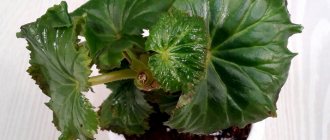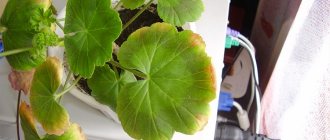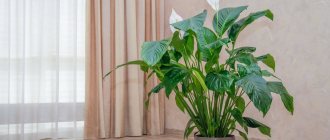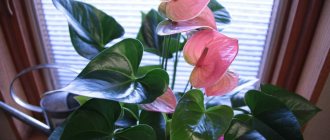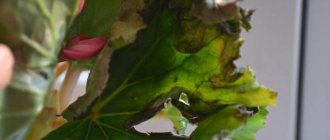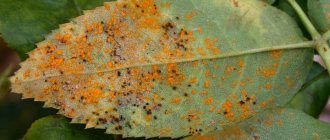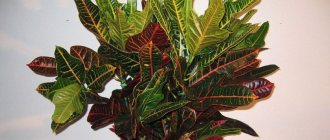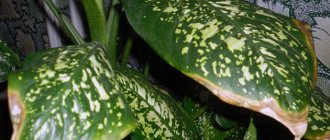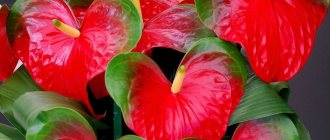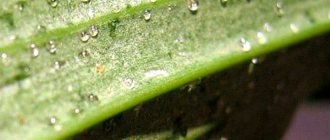Anthurium or Male Happiness is a plant with green heart-shaped leaves and flowers of red, white, pink, orange or even green. “Male Happiness” looks very beautiful and impressive, which is why it is loved by many flower growers. In order for its beauty to be preserved for many years, you need to know how to care for an indoor anthurium in a pot and why the flower’s leaves dry out, turn yellow, turn black, or it does not bloom. Once you find out the reason, you will immediately understand what to do to eliminate, or better yet, avoid problems when growing a plant at home.
Excess or lack of light
It is advisable to keep anthurium in partial shade - direct sunlight can cause burns on the leaves.
But it is also not recommended to place it in a too dark place - due to lack of lighting, the anthurium grows poorly and may not bloom. The leaves begin to turn pale from lack of light.
When there is an excess of light, anthurium leaves begin to turn yellow or may become bronze in color. You can also observe the appearance of brown spots on the tips of the leaves.
Excessive dry air
If the air in the room is very dry, the leaves of the anthurium also become dry. As a rule, this happens at the beginning of the heating season - after all, the plant has not yet had time to adapt to the changed conditions. If the air is too dry, yellowness first appears at the edges of the leaf and gradually moves towards the center. After this, the tips and edges of the leaves begin to dry. Dry air also leads to deformation of young leaves - they simply cannot unfold normally.
What to do: Provide the plant with the required humidity level of 70-85% using a household humidifier, or by placing containers of water next to the pot. A tray with expanded clay filled with water helps a lot. It is important that the roots do not have direct contact with the water in the pan, otherwise they will begin to rot.
What to do if you have problems with growth?
Not growing. If the anthurium does not grow, most likely the pot size is chosen incorrectly. It should be a little tight. Low containers with a diameter of about 25 centimeters work well. The composition of the soil also affects the growth of anthurium. If the soil is chosen incorrectly, the plant will not develop.- It grows upward, not in a bush. For some types of anthurium, for example Dutch, a non-clumping elongated stem is the norm, so for greater decorativeness, not one, but several plants are planted in a pot. To add splendor to an elongated anthurium, you can draw off the upper part. The stump will then grow new shoots.
- The stem has stretched out - why does this happen and what needs to be done? This symptom is typical for plants that have reached five years of age. Every five years, anthurium needs rejuvenation. To do this you need to re-root the top. It is better to do this in the spring.
- The upper part of the trunk is cut off so that a part of the trunk no more than ten centimeters remains under the lower leaves, with the rudiments of aerial roots.
- The cut is dried for an hour and the cutting is placed in water for rooting.
- The remaining stump in the pot is trimmed so that about five centimeters remain; more shoots will grow from it.
- The middle bald part of the stem is discarded.
Improper watering
If brown spots, dry areas and yellowness appear on the leaves of an anthurium, the problem is most likely due to improper watering of the plant. Both lack and excess of moisture have a negative effect on the flower. Excess moisture leads not only to yellowing of the foliage, but also to rotting of the roots, the appearance of mold and fungal diseases.
You also need to take into account that if there was water on the anthurium leaves (it got in after watering, etc.), this can cause brown spots to appear - the sun, through drops of water, like through a lens, burns the leaves.
With prolonged exposure to water, necrosis may develop on the leaves - it spreads along the leaf plate, starting from the edges, and gradually spreads throughout the entire leaf.
What to do: if the problem is too much moisture, try to completely dry the soil in the pot. You can even completely replace the entire soil. If you replant the plant, check all the roots for rot (it must be carefully cut off).
Helpful care tips
Anthurium is considered a rather capricious plant to care for, so there are a number of mandatory rules, the observance of which guarantees the healthy development of the plant and its active flowering:
- when purchasing a flower, you should place it in a container of the appropriate size;
- You can buy ready-made soil for planting, but it is better to use it as a mixture of humus, leaf soil, peat and sand. The proportions are: 2:1:1:1/2. Drainage and large fractions are required. You should also maintain soil acidity within 5.5–6.5 pH;
- It is recommended to place the flower on the windowsill, providing it with good, but not bright lighting;
- organize additional lighting in winter, otherwise you may not wait for flowering;
- It is better to place the pot with anthurium on the eastern or western windowsill in the summer, and move it to the southern one in the winter;
- do not place the anthurium where drafts are possible, but when ventilating, take the pot out of the room;
We advise you to learn about the varieties of anthurium: andre anthurium and red anthurium. - temperature regime: +20°С – +25°С in summer and +16°С in winter;
- It is recommended to water with slightly warm, settled water. In summer, water once every 3 days, and in winter - once a week. The volume of watering is moderate;
- if water remains in the pan after watering, it must be drained;
- it is important to organize sufficient air humidity in the room;
- leaves require systematic moistening by spraying. Excess moisture is wiped off. Moisturizing flowers is strictly prohibited;
- the soil requires fertilizing 2 times a month;
- Periodically, thorough inspections should be carried out for the presence of diseases and pests in order to take timely measures to prevent the death of the plant;
- It is better to replant plants in the spring, burying the plant a little lower than during the previous planting.
Growing anthurium will require some experience and patience, as well as the organization of comfortable conditions. But if you follow the recommendations and correct problems in a timely manner, you can get a beautiful bush with amazing leaves and unusual flowers.
Fungal disease on anthurium
If the room is cool and watering is poor, there is a high risk of fungal disease. When fungi begin to work, dry spots appear on the leaves. First, small yellow spots of irregular or round shape appear, then they begin to expand, and the center becomes brown and begins to dry.
The damaged areas may begin to crumble and dark circles may form around the area. But when fungi attack, not only the foliage suffers - the roots begin to rot. Therefore, you must definitely pull out the plant and check its roots, cutting off all rotten areas. Healthy roots should be light cream or white in color. If they turn brown or black, soft spots appear, possibly with areas of mucus - this is rot.
After cutting off the rotten roots, the cut sites are treated with crushed coal, and the anthurium itself is treated with a fungicide. In this case, before processing, you need to remove all leaves damaged by the fungus.
The pot needs to be disinfected and filled with fresh substrate.
How to save a plant
To protect the anthurium flower from any disease, it is necessary to provide sufficient care for it. To eliminate wilting and blackening of leaves, you will have to use fungicidal preparations.
Anthurium - home care: why leaves dry
Plant processing methods:
- If fungal diseases, bacteria or viruses are found on anthurium, the likelihood of cure is very low. All infected leaves must be removed immediately.
- When blackness appears, you need to spray the leaves from a spray bottle with a fungicide containing a lot of copper. When rust occurs, it must be sprayed on healthy bushes to increase humidity, and affected green leaves with spots must be completely removed and burned.
- To destroy anthracnose, reduce the amount of water and the number of waterings, and the anthurium roots are irrigated with copper preparations. The soil mixture in the pot must be treated with Abiga-Pik. If the flower cannot be cured, it must be burned entirely to prevent the disease from spreading to other crops.
Additional Information. To eliminate wilting, you will have to treat the plant with copper pesticides and irrigate the soil substrate with glycyrrhizic acid. It is best to dig the anthurium out of the ground and keep it in a dilute solution of potassium permanganate. Then grow the plant in fresh soil.
Rust on anthurium
Lack of nutrition or excess of it
If the anthurium begins to grow slowly, the young foliage becomes smaller, it is worth thinking about the proper nutrition of the plant. For example, with a lack of phosphorus, potassium and nitrogen, the foliage becomes brown. Lack of magnesium and calcium also affects the body in the same way. You can feed the plant with ready-made liquid fertilizer - it is better to do this weekly so that the anthurium can recover. At the same time, for fertilizing, use ¼ of the fertilizer recommended by the manufacturer. When the anthurium gains strength, you need to switch to feeding once every two weeks.
Excess nutrition can also harm the plant. In this case, it is recommended to completely change the soil in the pot. If there is an excess of nutrition, young leaves grow too large and pale, and can take on different colors.
Rot of the stem and root system
In this case, the plant begins to quickly wither; dark depressed spots appear on the basal part of the stem and on the surface of the roots, which are covered with a dense white coating. It's a fungus. Such mold may begin to appear on the leaves. Important: the disease is contagious and can spread to other plants.
What to do: remove from the pot, remove all areas affected by rot, treat the roots with a solution of potassium permanganate and a fungicide (phytocide, phytodoctor), completely replace the soil in the pot, having previously disinfected the pot itself.
Table - to help diagnose the disease
| Causes | Symptoms |
| Dry air |
|
| Bright light/direct sunlight |
|
| Lack of light |
|
| Watering with hard water, excess calcium |
|
| Watering with cold water |
|
| Waterlogging of the soil, overwatering |
|
| Lack of nutrition |
|
| Excess nutrition |
|
| Watering with chlorinated water |
|
| Hypothermia |
|
| Improper care |
|
Pests and diseases | |
| Anthracnose and septoria | Round or oval red-brown, yellow spots from 1.5 to 13 millimeters, often a black dot (spores) can be seen inside. The stain spreads across the leaf and forms holes. |
| Fusarium wilt | Massive, rapid withering of leaves and unnatural bending of peduncles and petioles, dark vessels are visible on the cut of leaves, roots rot. |
| Root rot | The leaves lose their shine, become lighter, and then turn black. Upon examination, the roots are rotten and frayed, the root sheath is separated from the core. |
| Powdery mildew | The leaves curl, turn yellow, become smaller, and a white coating appears on the underside of the leaf. |
| Rust | Red-brown spots on the bottom of the leaf and at the same time light spots on the top, death of the affected leaves. |
| Aphid | The leaves curl, turn yellow, and become covered with a sticky coating. Small green sucking insects are visible inside the leaves and on young shoots. |
| Trips | Affected leaves have an uneven yellow-green color, and the inside of the leaf is covered with black insect excrement. The leaves dry out and fall off. |
| Shchitovka | Whitish or golden tubercles on the leaves. |
| Spider mite | The leaf becomes covered with yellow specks, curls, and dries out. When finely sprayed, a web with insects is visible. |
| Mealybug | The affected parts of the plant seem to be dusted with flour |
You might be interested:
- Dieffenbachia leaves turn yellow
Dieffenbachia is a plant about which you can hear many different opinions. Some say that it is very... - Cucumber leaves turn yellow One of the problems when growing cucumbers is yellowing of the leaves. If measures are not taken in a timely manner, then...
- Why do monstera leaves turn yellow and fall off? Monstera is an unusual plant. Probably every owner of this marvelous vine has noticed that in cloudy weather...
How to save an anthurium if it turns yellow and withers after transplantation
The appearance of spots, yellowing and wilting of leaves can also be caused by improper replanting of the plant. After purchasing in a store, the flower needs to be quarantined and adapted to new conditions for a week. Even if the plant looks fine, it is recommended to transplant it into a new pot with a complete replacement of the soil.
In all other cases, anthurium transplantation is carried out using the transshipment method. This method will help the plant undergo the procedure painlessly. In addition, during transshipment, the root system of an exotic crop receives less damage.
Important! After replanting, you should not get carried away with heavy watering, which causes rotting of the roots and, as a result, yellowing and spotting of the foliage.
After moderately wetting the substrate, you can cover the plant with a plastic cap. This will delay the rapid evaporation of moisture and help the flower quickly adapt to new conditions.

